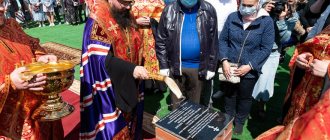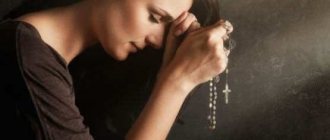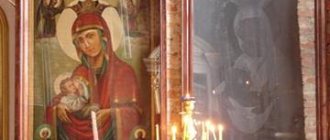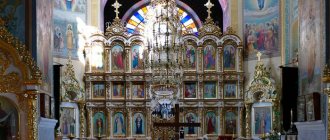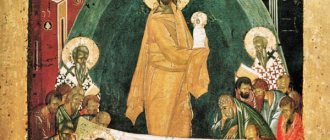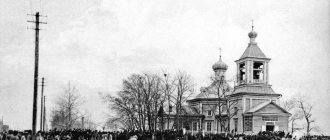There are many icons of the Mother of God, revered by the Orthodox Church, through which the help of the Queen of Heaven to people is witnessed. Traditionally, people pray in front of different icons of the Mother of God in different circumstances, different everyday difficulties. Remember that there is only one Mother of God, but each person can choose his favorite image of the Mother of God and pray to the Queen of Heaven in front of him. Dear Brothers and Sisters, we will be very glad if you subscribe to our group in, there you will find even more prayers, icons and other interesting information, here is the address link - Orthodox group! We are also pleased to remind you that on the pages of our Orthodox store you can find all possible Orthodox products!
Icon of Soothe my sorrows - iconography
On the icon of Soothing My Sorrows, the Mother of God is depicted up to her chest, hugging the Infant Christ to her. The face of the Mother of God is mournful, her expressive eyes are sad, and the Baby seems to console the Mother, holding Her hand. The Virgin Mary has a crown on her head, and a ribbon is drawn around the Mother and Son.
The theological meaning of the image is similar to other icons of Hodegetria. The Mother of God, with a gesture of her right hand, points those praying to Christ - the only Path to salvation and Life. The Mother of God reveals the Infant God to people, showing that only through faith in the Lord Jesus can one find the true path of life, the road to the Kingdom of Heaven. This Path must be followed in order to achieve salvation. Many other miraculous icons also belong to the iconographic type of Hodegetria, for example, the Seekness of the Lost, the Iverskaya. We remind you that you can always buy the icon of the Mother of God Soothe My Sorrows in our catalog, as well as buy an icon of the Mother of God, or buy personalized icons named after the Saint!
What does the image of the Mother of God look like?
This icon can be recognized by its special compassionate iconography, which was especially common in Rus'. This is evidence of how deeply the merciful Intercessor was revered for sinful people.
The meaning of the “Quench My Sorrows” icon lies in the fact that we believe and hope for the intercession of the Mother of God for us sinners before the Almighty.
“Sorrows” are not sadness for some reason, but mental and physical infirmities, weakening of faith, despair that has taken possession of the soul, overpowering by passions that destroy the soul and body of a person.
Sadness
Ask the Mother of God in front of this icon for deliverance from illnesses and sorrows. Heaviness in the heart and melancholy will not have their power if the person to whom evil is wished is a church member, believes in God, goes to church, attends church services and partakes of the Mysteries of Christ.
Dejection and despair become a sin when we curse God, believe that He is to blame for our misfortunes, that He does not help us. Try to learn lessons from the situations you find yourself in.
First of all, in case of melancholy due to family circumstances, prayer to the Mother of God is necessary. The prayer before Her image “Quench my sorrows” can be read for help in various family sorrows, with a request for help in a difficult pregnancy.
"Quiet my sorrows." Where did this amazingly touching name of the Mother of God come from?
From the prayer texts to the icon we can conclude that the title “Quench my sorrows” is nothing more than a prayer to the Mother of God for deliverance from numerous illnesses and sorrows of the body and especially the soul, i.e. sinful passions overwhelming the heart.
In a life full of adversity, who has not experienced sorrow? Who can say about himself that in his life’s journey he did not experience difficult moments of misfortune and did not look for support or consolation from anywhere?
A Christian, despite all the difficult and sad circumstances of his temporary life, involuntarily mentally turns to where he expects help. And, indeed, it is not from people, who are also weak by nature, that he receives true medicine, but from the Lord himself through the intercession of the Most Holy Mother of God with Him.
Description of the icon: In the icon, the Mother of God is depicted with her right hand holding the Infant Christ, in Whose hands a scroll is unfolded with the words: “Judge righteous judgment, do mercy and generosity to everyone who is sincere; Do not force a widow or an orphan, and do not create malice in your brother’s heart.” The Mother of God placed her left hand on Her head, slightly tilted to one side, as if she were listening to the prayers of all those who turn to Her in sorrows and sorrows.
History of the image of the Icon of the Mother of God “Quench My Sorrows”: The first known icon from the 17th century “Quench My Sorrows” was located in the Belarusian city of Shklov. This image was brought to Moscow by the Cossacks in 1640 under Tsar Mikhail Fedorovich. However, the Zamoskvoretsky copy of the icon, located in the Church of St. Nicholas, on Pupyshi in Sadovniki, received special, all-Russian glorification. At one time, probably as a result of a fire and repeated reconstructions of the temple, the icon was forgotten; it was abandoned and was in great neglect in the bell tower. But the abundant mercies shown through her by the Mother of God forced us to remember the forgotten shrine and give it its rightful place in the church, in which a chapel was subsequently built in her honor. This church kept records of many miracles that occurred from the miraculous icon of the Mother of God. Especially many miracles happened during the plague of 1771. Later, the documentary evidence was destroyed by fire during a fire. Tradition, however, has preserved the memory of many miraculous events, the most famous of which is the following incident, which marked the beginning of the veneration of the icon as miraculous.
One woman of noble origin, who lived far from Moscow, was bedridden for a long time, suffering from a debilitating illness. Doctors no longer hoped for her recovery, and the woman expected a fatal outcome. But one day in a dream, the sick woman saw the Mother of God, who told her : “ Tell yourself to be taken to Moscow. There, on Pupyshev, in the Church of St. Nicholas, there is My image with the inscription: “Quench my sorrows,” pray before it and you will receive healing.”
The woman shared what she had seen with her relatives, and with deep faith everyone set off on a difficult journey for the sick woman and, upon arrival in Moscow, found the indicated temple. However, having examined the entire church, the arrivals did not find the image that appeared to the woman in a dream. Then the priest, to whom the sick woman turned for advice, ordered the clerks to bring all the icons of the Mother of God from the bell tower. Among the dilapidated and dusty icons brought, they found an icon of the Mother of God with the inscription: “Quench my sorrows.” Seeing him, the patient exclaimed: “She! She!" - and, who had not previously had the opportunity to even move her hand, to the surprise of everyone, she crossed herself. After the prayer service, the woman venerated the icon and rose to her feet completely healthy. This healing took place on January 25, 1760. Since then, it was established on this day to celebrate a festival in honor of the icon of the Mother of God “Quench my sorrows.” The service with an akathist, first published in 1862, also dates back to that time.
After the destruction by the atheistic authorities in the 1930s of the St. Nicholas Church in Sadovniki, the image of the Mother of God was transferred to the Church of St. Nicholas in Kuznetskaya Sloboda, where it is now located in the northern aisle, consecrated by Metropolitan Philaret (Drozdov) of Moscow in honor of the Entry of the Theotokos.
The restoration of the image was carried out in the middle of the last century by a parishioner of the St. Nicholas Church, icon painter, restoration artist and professor at PSTGU Irina Vasilievna Vatagina.
The feast of the icon, February 7, in the Nikolo-Kuznetsky Church is always celebrated very solemnly by the bishop's rite.
The parishioners have a tradition: before the start of the service, they venerate the miraculous image.
Troparion to the Most Holy Theotokos in front of Her icon called “Quench My Sorrows”
Troparion, tone 5
Assuage the sickness of my much-sighing soul, Who has quenched every tear from the face of the earth: You drive away sickness with man and destroy the sorrows of sinners, For You are the source of hope and affirmation for all. Most Holy Mother of God.
Kontakion, tone 6
The intercession of Christians is not shameful, the intercession to the Creator is immutable, do not despise the voices of sinful prayers, but advance, as the Good One, to the aid of us who faithfully call Thee: hasten to prayer, and strive to entreaty, ever interceding, the Mother of God, who honor Thee.
Prayer before the icon of the Mother of God Soothe my sorrows
The hope of all the ends of the earth and of Your servants (names), You, Most Pure Virgin, Lady Theotokos, are our consolation! Do not disdain us, sinners, for we trust in Your mercy. Quench the flame of sin in us and irrigate our withered hearts with repentance, cleanse our minds from sinful thoughts; accept the sigh from the soul and heart of those who bring you the prayer. Be an intercessor for us to Your Son and God, and tame His righteous fury with Your Mother’s prayers. Heal mental and physical ulcers, Lady Theotokos, quench the illnesses of souls and bodies, calm the storm of evil attacks of the enemy; take away the burden of our sins and do not leave us to perish until the end. For you are the builder of the human race, an ambulance in sorrow. True Mother of Christ our God, help us, Thy sinful servants always, now and ever and unto ages of ages. Amen.
What to listen to when you're sad
Feeling sad or hopeless is not a sin. You need to immediately turn to God’s help, and not “force” yourself with fun: • Turn to God in a special prayer, daily lighting a candle in front of the icon; • Believe in the existence of God as a Person, in the coming to earth and the Resurrection of His Son - the Lord Jesus Christ. Pray at home using a prayer book or find prayers on the Internet - the most common ones are, for example, “To the Heavenly King,” “Theotokos, Virgin,” and “Our Father.” • Reflect on your life, prepare for confession - perhaps you have committed mortal sins or yourself have caused evil to people, and now you are tormented. • Be sure to visit the temple and talk with the priest. Perhaps you have not been baptized and therefore are defenseless against evil spirits; perhaps you rarely call on the Name of God and rarely go to church. This is a reason to reconsider your life, turn to the Lord more often, learn the basics of the Orthodox faith and come to the church Sacraments of Confession and Communion. Prayer will always help • Protect yourself and your loved ones from the influence of dark spirits (after all, despondency is even called the “midday demon”); • Maintain peace, tranquility and well-being; • You entrust yourself to the protection of God - which means you are fulfilling God’s commandment about humility and trust in Him. With God's help you should be calm.
There are a number of prayers to saints, miraculous icons of the Mother of God and prayer services that have the special grace to help with depression, melancholy, mental laziness, and in certain hopeless circumstances.
History of the appearance of the icon
The image of the Mother of God appeared to the people in 1640, in Moscow. Until this time, the dilapidated icon was in Shklov, Mogilev province. Later, the Cossacks made a list of it and took it to Moscow. The icon was placed in the Church of St. Nicholas the Wonderworker in Zamoskvorechny Pupyshi. Then she somehow ended up in the church bell tower, and for a long time they didn’t know anything about her.
As the legend says, one well-born woman became very ill and could not even move. The doctors treated her for a long time, but their efforts were powerless. Then the patient asked to bring her icons of saints so that she could pray in front of them.
They brought her different icons, but there was no healing. Then they brought all the icons of the Most Holy Theotokos to the sick woman, and even found the one that was on the bell tower. A woman, lying motionless, having seen the image of the Mother of God “Quench my sorrows,” was suddenly able to apply the sign of the cross to herself.
At the end of the prayer service, the woman wanted to venerate the miraculous icon. After this, the patient felt such strength that, without outside help, she was able to get to her feet and independently leave the Church of St. Nicholas, where a prayer service was being held. This miracle happened on January 25 according to the old style (February 7 according to the new style). This day is celebrated as a significant Orthodox holiday.
The story of sudden healing reached the most remote corners. Pilgrims began to flock to the temple and pray before the miraculous image of the Mother of God “Quench my sorrows.” The priests recorded all the healing miracles, but all the records were burned in a fire in 1771. Only those legends that were remembered by eyewitnesses and told to others have reached us.
The icon of the Blessed Virgin Mary is one of the most revered in Rus'. Our Lady is considered the patroness of Rus' and our intercessor before the Lord. People turn to her in difficult moments of life.
Prayer to the icon Quench my sorrows
The prayer to the icon of Soothe my sorrows in Russian can be read online. This is a kontakion that is read annually before the icon on its feast day, but you can pray with these short words at any time, just as you can address the Mother of God in your own words.
“Do not leave me only in human power, Most Holy Lady Theotokos, but accept the prayer of Your servant. There is sorrow around me, I cannot endure devilish attacks, I have no protection under which I, a sinner, would come, and I have no consolation except You, O Heavenly Lady, Hope and Intercessor of the faithful before God - turn away from my prayer and give me everything that is useful!
May the Mother of God protect you and deliver you from all sorrows!
The value and significance of prayers to the Mother of God
In various life circumstances, people turn to exactly where they expect help. Therefore, Christians turn to the intercession of the Most Holy Theotokos. The Orthodox Church teaches that the Mother of God, standing before the throne of God, is ready to help those who ask for Her help. Many people felt and still feel Her motherly love and care, shown through numerous miraculous images. That is why the Orthodox do not give up prayers to the Mother of God, believing that She will give strength to overcome all sorrows.
“The Most Holy Theotokos rejoices when we pray to Her, read akathists and canons. For She sees the pure love of Her children, who surrender themselves to Her and glorify Her. And of course, this encourages Her to lavish generosity on Her children. If we constantly read the prayer “Most Holy Theotokos, save us!” - then it’s as if we are tugging at the hem of Her clothes until She fulfills what she asks” (Reverend Paisius the Svyatogorets, 1924-1994).
Prayers
Troparion, tone 5
Assuage the sickness/ of my much-sighing soul,/ Who has quenched every tear from the face of the earth,/ For you drive away the sicknesses of men/ and destroy the sorrows of sinners,/ For all the acquisitive ones give you hope and affirmation,/ / Most Holy Mother of God.
Kontakion, tone 6
The representation of Christians is unshameful, / intercession to the Creator is immutable, / do not despise the voices of sinful prayers, / but advance, like the Good One, to the aid of us, / faithfully calling to You: / hasten to prayer and labor come to supplication, // interceding ever since, the Mother of God, who honor Cha.
How to recognize a miraculous icon
The icon has one noticeable detail: a hand near the face of the Mother of God. Her bowed face and left hand, which rests on her cheek, show that the Intercessor listens to us very carefully, empathizes with us in our sorrows.
This gesture brings the holy image closer to mortal people, once again proving that She was a simple woman. But for her purity and pious life, she was chosen for a holy role - to become the Mother of the Savior of all mankind.
The Heavenly Intercessor is ready to listen to the prayer of any person. But She also calls on each of us: to live according to conscience, not to sin, and to remember the Judgment at the end of our earthly journey.
Our Lady will pray for us, so that every sinner can repent and receive the forgiveness of the Lord. After all, the repentant has the right to forgiveness and strengthening of the strength that will be sent through his prayer to the Intercessor.
How to properly celebrate a church holiday
The celebration in the church takes place over two days; the night before there is usually an all-night vigil. These are echoes of the ancient Christian tradition, when people prayed literally all night. Church services begin at different times, so you should carefully read the schedule - it usually hangs near the entrance. The name of the holiday, the date and time of the beginning of the service are indicated.
You should come to the service in advance, in appropriate clothing (women - in scarves and skirts, without lipstick). During prayer, the rules of decency require turning off the phone, not talking loudly, especially not laughing, not making noise. In some temples, women stand separately from men, but in general today this is not necessary. After the service, you must try to behave appropriately for as long as possible - do not smoke, do not express yourself, do not quarrel with your family.
Veneration of the icon in the temple
The Orthodox Church provides for special services that are held on days of veneration of a particular image or saint. Thus, churches consecrated in honor of the “Quench My Sorrows” icon celebrate their altar every year on February 7th. On these days, special solemn services are held here, which are always attended by many believers, pilgrims and guests. Participation in such a service bestows special spiritual joy and awe, so you should not miss the opportunity to take part in the patronal feast.
In other churches, on the day of veneration of this icon, prayer services and reading of akathists may be held. The image is placed on a lectern in the middle of the temple, where people come up and venerate it with prayer.

